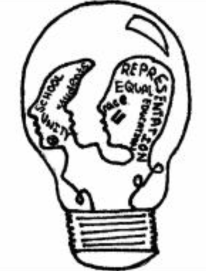Our editorial: Building global citizens requires diverse leaders

Photo credit: Anna Post
January 20, 2018
Throughout the years, school systems across the United States have made efforts to introduce minority faculty. But, as the student population at North continues to become more diverse in terms of ethnicity, religion and gender and sexual identity, the education system and its faculty must accommodate this shift.
Naming English teacher Geoffrey Young as interim assistant principal is a step in the right direction, but it’s just a start. As the demand for diversity within school faculty increases, the racial and ethnic makeup of the teaching staff throughout our school system doesn’t reflect the growing trends.
In the 2011 Schools and Staffing Survey (SASS) — a nationally representative survey of teachers and principals — done by the U.S Department of Education (DoED), 82 percent of public school teachers identified themselves as white. In a similar survey conducted by the Department of Education in 2000, 84 percent of public school teachers identified as white.
While a more diverse group of applicants have entered the profession in recent years, their numbers have not kept pace with the perpetual K–12 student demographic shift. According to the National Center for Education Statistics (NCE), 45 percent of students are minorities, and only 17.5 percent of teachers with differing racial and religious backgrounds are present in the educator workforce. In fact, according to a report by the DoED, every state has a higher population of students of color than teachers of color.
The statistics reveal drastic, yet predictable imbalances in the education system across the United States — imbalances that have in turn, caused tension amongst minority students, their fellow classmates and teachers.
For students with mixed backgrounds, representation is important, especially within the classroom. With strong representation in our staff, students can relate to and establish a deeper connection with a professional that looks like them or even shares a similar life story. Teachers are role models for the youth, and students seek inspiration from those who have the ability to positively influence their lives. North is 30 percent African-American, and as Young says, seeing people “who belong to your group succeeding, it really can be inspirational.”
At North, we’re a cultural melting pot that consists of numerous ethnic and religious backgrounds, one which has been growing more diverse in the past decade. Nationally, as the percentage of minorities continues to increase at the current rate, researchers predict minority students to makeup 56 percent of the student population by 2024.
With such a diversified student body, similar representation within our school faculty is critical — especially when this change could help build stronger relationships between students and teachers and also provide societal harmony throughout our school system.
With all of these statistics in mind, the resolution seems easy: make a conscious effort to introduce varying minorities into the workforce. However, when delving deeper into the matter, the issue at hand becomes more concrete.
According to the American Association of Colleges for Teacher Education, out of all people getting into the education field, is it made up of more than 80 percent of whites, while 15 percent of students are black and the remaining five percent come from other racial or religious backgrounds. Similar to the bachelor degree recipients who majored in education, those who went on to teach and those who were certified to teach were also predominantly white.
While schools push for a diversified environment, there are very few individuals with different racial and religious attributes. This issue only adds to the social divide, making underrepresentation in the workforce a detrimental problem with no immediate solution.
The limited number of minority educators makes this cultural shift extremely difficult. However, despite the statistical proof, these broken bridges within our school system — whether they are broken by race, ethnicity, religion, gender or sexuality — can be mended over time. By creating a welcoming learning and working environment, it will allow professionals from all ends of the minority spectrum to become more involved with today’s youth.
This positive reinforcement not only would promote a welcoming and productive professional and educational environment, but can also inspire students from all backgrounds to pursue education in their future. Through extensive outreach to colleges and high schools, educators will be able to spread awareness when in regards to the importance of diversity and collaboration.











